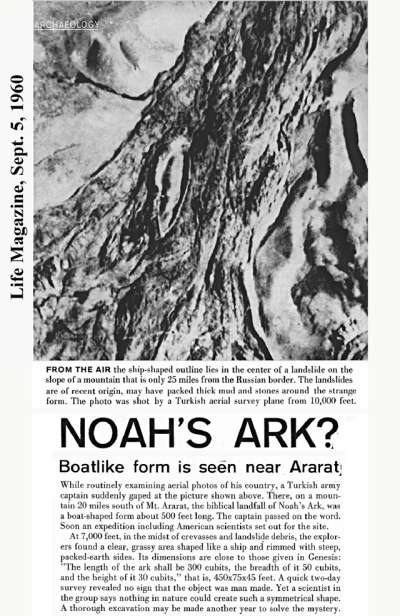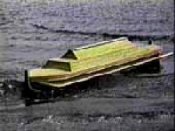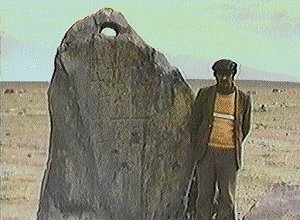Newsletter July 1994
The Discovery of Noah's Ark
By Mary Nell Wyatt
NOAH'S ARK--The Early Years
In September 1960, 27 year-old Ron Wyatt, along with thousands of other
people, read the following article in
Life
Magazine about an exciting boat-shaped
formation in the region of eastern Turkey named Ararat:
"NOAH'S ARK?
Boat-like form is seen near Ararat

"While routinely examining aerial photos of his country, a Turkish army
captain suddenly gaped at the picture shown above. There, on a mountain 20 miles
south of Mt. Ararat, the biblical landfall of Noah's Ark, was a boat-shaped form
about 500 feet long. The captain passed on the word. Soon an expedition
including American scientists set out for the site.
At 7,000 feet, in the midst of crevasses and landslide debris, the explorers
found a clear, grassy area shaped like a ship and rimmed with steep,
packed-earth sides. Its dimensions are close to those given in Genesis: 'The
length of the ark shall be 300 cubits, the breadth of it 50 cubits, and the
height of it 30 cubits,' that is, 450x75x45 feet. A quick two-day survey
revealed no sign that the object was man made. Yet a scientist in the group says
nothing in nature could create such a symmetrical shape. A thorough excavation
may be made another year to solve the mystery." LIFE

Ron's Decision is Made
At that time, Ron determined that one day, he would visit the site and see
it for himself. But that was a dream he could scarcely realize anytime soon. He
had a sixteen month-old daughter, a three month-old son, and within thirteen
months, he would have another son. He was working as a lab technician in the quality
control lab at Hercules Powder Plant in Kalamazoo, Michigan, and also
attending Western Michigan University studying pre-med.
But soon family matters forced him to give up his hopes of becoming a doctor
and he moved to Kentucky in 1964, where he entered nursing school. He graduated
in 1967, and entered anesthesia school and graduated as a Certified Registered Nurse
Anesthetist in 1970. It was also in 1970, that he found himself raising his three
young children alone.
It didn't look like there would ever be any opportunity for him to visit the
boat-shaped site, so he had to limit his archaeological research to
libraries and book stores. But he never lost interest -- in fact, he studied
everything concerning ancient history and archaeology, not just subjects
concerning Noah's Ark.
He had found that there was very little information available on the subject
of Noah's Ark, which convinced Ron more than ever that no serious research had
ever been undertaken on the subject. Everything he had read was based on
folklore and unsubstantiated claims, and all the sightings were in different
locations.
Hawaii
From 1973 to 1975, he and the children lived in Hawaii, where he was able to
study volcanoes firsthand. This convinced him that if the ark had landed on the
volcanic peak called Mt. Ararat, that it would have been destroyed long ago. Despite the fact that there are those who have written elaborate explanations of
how the ark could have survived on the volcanic peak, we learned later that the
eruption of Mount St. Helens showed that NOTHING could survive on a
volcanic mountain such as Ararat. If the ark had ever been there, he concluded
it would have long ago been destroyed.
Building Mountains
Moving back to the mainland in 1975, he decided that there was one form of
research that he could do -- he built a small boat model the same ratio as the
ark as stated in the Bible, and then he built various mountain configurations
in a stream.

By floating the model down the stream, he observed the boat's reaction as it
approached the various rock shaped "mountains". What he learned was that when the
boat approached a simple peak extending out of the water, it simply floated
around it, not approaching it or certainly not landing on it. This was the
law of physics known as the "lateral displacement" of an obstructed gas or liquid flow.
He continued this experiment with several shapes with the same result each
time. That is, until he built a crescent-shaped formation, with the crescent
concave side facing down-stream. When the boat accelerated around this crescent-shaped
mountain, he saw that it was pulled into the area within the crescent by the
eddy effect, whereupon it gently floated within that area.
With this bit of information, Ron felt like the ark would have
harbored in such a location. The laws of hydrodynamics and water action and
reaction were the same then and now. If the ark had approached a mountain peak
extending out of the water, the water displacement around the mountain would
have carried the ark with it.
The study of water as a fluid, with its unique properties, and the study of
hydrodynamics (fluid mechanics) and wave causation and motion is a most involved
and complicated science. The actions and reactions of water and an object
floating on that water cannot possibly be studied in-depth here -- but some
simple rules must be understood.
If your ship on the open sea approaches a mountain extending out of the
ocean, only one of two things can happen:
1) The ship will be carried around the mountain with the lateral water
displacement, or
2) The waves can be of such force and direction that they carry the ship
right into the side of the mountain, with such force that the ship would break
into pieces.
But it would NOT come to rest on that steep mountain side. It just wouldn't
happen. If that mountain peak were directly under the ship and the waters
slowly descended, the ship STILL wouldn't land on the mountainside (such as on
Mt. Ararat). The water displacement and movement around the underwater mountain
would still cause the ship to be removed from the mass (of the mountain) with
the water.
The necessary criteria for a ship to land on a mountainside as sea waters
descended, would involve a process by which the water displacement would trap the
ship within an area, such as an eddy could do. At least, that's what Ron
believed and later found to be true, based upon the formation of the mountains
at the ark site.
The Size of the Ark
One of Ron's favorite subjects of study was the ancient Egyptians, as they related
to the biblical account. While in Hawaii, he had read everything he could find
on the subject in the library.
And as he mulled over all the information in his mind, there was one thing
that seemed to be obvious to him: He knew that Moses had been the author of the
Genesis account and therefore the flood story - and as such, Ron believed that
the type of cubit Moses would have been accustomed to, would have been the Royal Egyptian Cubit, the
most universal standard of measurement in the ancient world at that time. There
was no Hebrew Cubit in existence during Moses' time, and to Ron, the 500 foot
measurement given in the Life article was even more compelling evidence that
the site needed thorough exploration. After all, 300 Royal Egyptian Cubits
equals 515 feet which is similar to the ark formation, but the Hebrew Cubit is
only 450 feet and comes into existence much later after Moses.

1975- The Ark File
It had now been 15 years since he had read that article, but his interest
never waned -- it only grew. Then Ron read the book, The Ark File by Rene Noorbergen, who just happened to be a member of that 1960, expedition to the
boat-shaped formation. Until this time, Ron had no more information on the
boat-shaped object other than what he had read in Life Magazine, but now he
knew the names of the very men who visited it.
So, he contacted all but one of the American members of the expedition and
gleaned from them everything they could tell him. When he told them he wanted to visit
the site, they all basically told him he was crazy to do so. They were all
adamant that nothing was there- that is, all except one man, Dr. Arthur Brandenburger who still believed it was a ship.
He asked them how to get to the site- after all, "20 miles south of Mt.
Ararat" is a pretty vague location in a region that is very mountainous. But no
one could tell him exactly how to get there because they had ridden on horseback
for many hours to the site, while being led by the Turkish military.
1977 -- Time to Go to Turkey!
In 1977, for the first time, Ron felt like his children were old enough for
him to either leave them alone at home or take them with him to Turkey. For the
first time he had two weeks of vacation from his job, while also having enough
money to go to Turkey.
It was now 17 years since he first read about the site. He told the
children what he was about to do and to his dismay, the boys, Danny who had just
turned seventeen, and Ronny who would be sixteen in 2 months, insisted on going
too. Torn about whether to take them or not, he did the only thing he knew to do
-- he said a little prayer that if the boys were supposed to go, that they would
receive their passports before the departure date, AND, there would be seats available on the
chartered flight from New York to Istanbul.
He had been told that he had booked the last seat on the flight, and when he
called to check on availability, he was again told that none were available. It
was now within a week of his departure date. But two days later, he received a
call from the airline - it seemed that two seats had come open at the last
minute and he was asked if he wanted them. There was still the matter of the boys getting
their passports, a procedure which usually took several weeks. But in three
days, Danny's was back, and the next day Ronny's arrived. Yes he wanted the
seats.
But Where Is It?
On August. 9, 1977, they arrived in Istanbul, Turkey. Things were a lot different
then than they are today -- they had to take a bus to Ankara, and then a train
to Erzurum. This consumed three valuable days and they were still not in
Dogubeyazit, the little town near the ark site. In Erzurum, they took a taxi to
Dogubeyazit, directing their driver to take them to a hotel there. But Eastern
Turkey is no thriving tourist area. It is remote and dangerous. Very few people
speak English. How would they ever find the boat-shaped object in the few
days they would have
there?
Many people may find Ron's method of getting information strange, but again
he did the only thing he knew to do -- he prayed about it. He told the boys to
say a prayer that the taxi would stall at the place where they were to begin
looking for the ark. After all, their taxi driver spoke no English, they didn't know if
anyone in the town could speak English -- and even if they did, would anyone
know where this boat-shaped object was? It had been seventeen years since the
expedition had come there- perhaps the townspeople had forgotten all about it.
The Stalled Taxi
They all prayed -- not some great elaborate prayer, but just short,
silent prayers for help. To Ron's way of thinking, if Noah's Ark was real, then
the rest of the Bible was surely just as reliable, including everything said
about prayer. As they approached the town, the taxi stalled.
Full of excitement at seeing their prayers answered, they all three climbed
out of the taxi and piled a great number of rocks on the side of the road as a
marker, while
the bewildered driver peered under the hood of the taxi. When they all got back in the taxi,
it started up and they continued on down the road.
Soon it stalled again. With a little bit less enthusiasm, they again piled
up rocks on the roadside. Again, the taxi started up when they all got back in.
Finally, it stalled again, and thinking that perhaps they had just gotten a
defective taxi, they each placed one rock in a pile along the side of the road.
This done, they headed to the hotel.
It was late when they arrived at the Erzurum
Hotel in Dogubeyazit. They all fell asleep, completely exhausted from their long
journey. The next morning, they hired another taxi and headed back to the third
and closest pile of rocks, where they began walking in a perpendicular direction from
the road.
DAY 1- The Anchor Stones
They soon came to a small village where several very intimidating men
approached them, one with a shotgun. Communicating in hand gestures, Ron
convinced the men that they were just tourists. Soon the villagers appointed
themselves Ron's tour guides.
Walking over miles and miles of rugged terrain, one of the men motioned for
Ron to take his photo by a very large, standing rock. Only when he looked through
the viewfinder did Ron realize that this rock was identical to the ancient ship anchor
stones found in the Mediterranean Sea that he had seen in archaeological books.
That is, except for one thing -- this "rock" was many, many times larger!

When he examined it more closely, he saw that it had eight crosses carved on it. When the villagers saw Ron's interest in this, they showed him several more in
the area -- all exactly like other ancient anchor stones except again, many, many,
times larger -- and most with crosses carved on them.
They were all terribly excited by what they had seen, but the boat-shaped
object was nowhere in sight. As they continued to walk, they showed Ron and the
boys a very ancient graveyard which had strange monuments in it which looked
like simple representations of a three story boat. Were these objects connected
to Noah's Ark? Ron believed they were. He photographed and filmed everything
with his 8mm movie camera (No video cameras back then!) and they decided to head
back to the hotel for the night.
DAY 2 -- The House and Fences
The next morning, they returned to the second pile of rocks and began to walk
out from the road in a perpendicular direction again. This pile wasn't too far from the first and
they soon found themselves looking at the walls of a very, very ancient stone house
whose floor seemed to be set about four feet into the ground, as topsoil had
covered it over the years. The roof was gone
and it was apparent that no one had lived here for a great number of years.
Radiating out from the house was a very large pattern of stone fences which
seemed to go on for miles. These too seemed to be covered by several feet of
dirt with only the upper part extending above the earth.
The Tombstones
The most interesting feature of this site were the objects in the front yard
-- there were two large stones, one standing upright and the other lying flat on the
ground. Carved on these stones was a most exciting picture: across the top of
each was an arc-shape [rainbow]; below this was a curly-cue which looked like an ocean
wave, and atop it was a very simple boat-shape; walking away from this boat and
wave were eight people -- the first and the largest was Noah; next and second
largest was Mrs. Noah; the next three were all slightly smaller - representing
the three sons of Noah; and the last 3 were slightly smaller and represented the
wives of the sons.

It seemed quite obvious to Ron that these were iconographic representations
of the eight survivors of the flood, all walking away from the ship with a rainbow
overhead. But what did it all mean?
When he studied these two large monuments more closely, he noted that on the
one lying on the ground, the largest woman - representing Mrs. Noah,
had her eyes closed and her head tilted downward. On the larger tombstone which was
still standing, he saw that BOTH the first woman AND the first man (Noah) had
their eyes closed and heads tilted downward. Since these were in front of the
house, he believed they were the actual tombstones of Noah and his wife!
The iconography showed that FIRST Mrs. Noah died, and on her stone only her
eyes were closed. When Noah died, BOTH of them were represented as dead.
Ron felt that what he and the boys had found these first two days was extremely
important. While they didn't prove anything about the boat-shaped
object, there were clear indications that a family of eight people had lived in
this exact area during some ancient time. The eight-cross design on
the anchor stones showed that someone during the Christian era had identified
these huge rocks with the ark and its eight passengers.
(to be continued next page)
Next Page:
The Quest for Noah's Ark
Index of Newsletters
Home
This page courtesy Anchor Stone International,
www.anchorstone.com
|

![]()